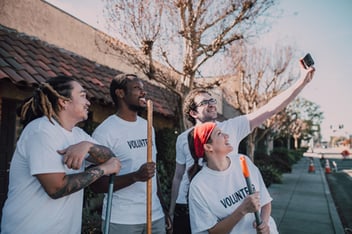Free Microvolunteerism Planning Guide
What if people could volunteer in the time it takes to scroll through Facebook? These days, many people want to take action but need quick and flexible opportunities to engage with the causes they care about.
Enter microvolunteering. It’s a convenient form of community action that’s gaining traction across the country and worldwide.
But is microvolunteerism worth your organization’s time? Learn more about this trend in volunteering, whether it’s suitable for your organization, and how to introduce microvolunteerism to your program.
Article Contents
- What is Microvolunteering?
- Microvolunteering Benefits and Challenges
- Is Microvolunteering Right For Your Organization?
- How to Introduce Microvolunteering to Your Volunteer Program
What is Microvolunteering?
Microvolunteering is an approach to community action that allows people to volunteer quickly and conveniently. If your volunteers have a minute or an hour, they can support meaningful nonprofit activities. The idea is that people can create big change in small increments.
Microvolunteering occurs on an ad-hoc basis; microvolunteering opportunities are often unscheduled or one-off activities, and tasks can be completed on volunteers’ terms, either virtually or in person.
Unlike traditional volunteering, microvolunteering typically does not require an application process or screening. An organization will post microvolunteering tasks on its website or social media channels. Volunteers can then complete these tasks online, from their smartphones, or in person.
Microvolunteerism: Passing Trend or Here to Stay?
Microvolunteering has been around for years. In fact, many of us take part in microvolunteering activities in our daily lives. If you’ve ever donated used clothing, helped your neighbor with their groceries, or picked up trash on your daily walk, you have given a small amount of your time or money to someone else. Microvolunteering mirrors everyday good citizenship by asking people to complete simple, episodic tasks.
But if microvolunteering is on your radar this year, it’s probably no coincidence. Virtual and remote volunteering has become increasingly commonplace. As many doors shut during the COVID pandemic, virtual volunteering opened new ones for community organizations.
Online and remote volunteer opportunities offered increased flexibility and accessibility for those who wanted to get involved but were previously limited by time or location constraints. Microvolunteering plays on the notion that anyone can take community action from anywhere.
What’s more, people are leaning on smartphones now more than ever. There are nearly 3 billion smartphone users on the planet, and the average smartphone user will tap, swipe, or click their phone 2,617 times per day. Imagine how much your organization could accomplish if you replaced time spent scrolling through social media with a meaningful activity!
Microvolunteering Examples
One of the most prominent examples of microvolunteering was the ALS Ice Bucket Challenge. Social media users created and shared videos to raise awareness and call for donations. The challenge went viral in 2014. Individual contributions added up to $115 million in research funding, dramatically accelerating the fight against ALS.
Another groundbreaking example of microvolunteerism: Be My Eyes is a mobile app designed to make the world more accessible to blind and low-vision people. The program employs “small acts of kindness” to make a global impact. In fact, since launching in 2015, nearly 6 million volunteers have signed up to assist blind and low-vision users around the world. Volunteering with Be My Eyes only takes a few minutes, but these minutes make a big difference to the lives of app users.
So maybe you haven’t created a viral video or developed a worldwide app, but these examples prove that quick acts of service can add up to powerful change. Your organization can also leverage microvolunteering to impact your community.
Here are some examples of microvolunteering activities:
- Share a post on social media to raise awareness or ask for donations
- Sign a petition
- Donate supplies or collect donations
- Fill out a survey
- Translate a document
- Record a video
- Donate skills, such as graphic design
- Tend a community garden or pick up trash
Microvolunteering and Corporate Volunteerism
It’s worth noting that microvolunteerism is a viable (and increasingly popular) option for corporate volunteerism, too. In fact, the term microvolunteerism was inspired by the work of Ben Rigby, CEO of Sparked, who wanted to find ways to connect his employees to quick, manageable volunteer activities.
Microvolunteerism is a great option for busy employees who want to volunteer but aren’t ready to commit to a long-term project. If your organization engages with corporate partners, consider incorporating microvolunteering opportunities into your program.
Microvolunteering Benefits and Challenges
Let’s learn about the benefits and challenges of microvolunteering to organizations:
Microvolunteering Benefits
Microvolunteering can help organizations get important work done one task at a time. Microvolunteering allows organizations to:
- Cast a wider net to attract more diverse volunteers. Some organizations might have an easier time attracting first-time volunteers with these convenient, accessible volunteer opportunities.
- Increase awareness. Employ your network of microvolunteers to share your social media pages and drive traffic to your website. In this way, microvolunteers can serve as ambassadors for your program.
- Create a pathway for long-term engagement. When executed well, microvolunteering can introduce people to your cause and keep them engaged, so they’re more likely to turn to your organization when looking to volunteer or donate.
- Access skilled volunteers. Tap into the expertise of skilled volunteers around the country by offering remote, online microvolunteering opportunities.
- Engage existing volunteers. Keep your existing traditional volunteers excited about your organization by offering new, accessible opportunities to complete throughout the year.
Microvolunteering is great for volunteers, too! Time-strapped individuals can now explore the causes they care about on their terms.
While there are plenty of benefits to microvolunteering, the trend is not without its challenges:
Microvolunteering Challenges
Microvolunteering often relies on your network of social media followers, volunteers, and community members to share micro-opportunities and information, making it more challenging to track one-off activities and manage microvolunteers.
What’s more, microvolunteering is designed for people who want to participate in quick one-time projects, so it’s harder for programs to rely on these volunteers throughout the year. Many programs need committed volunteers to move the needle on complex community needs. Therefore, microvolunteering should not replace traditional volunteering but rather support your existing programming.
Is Microvolunteerism Right for Your Organization?
This form of volunteering has garnered increasing popularity in recent years, which begs the question, is microvolunteerism worth your organization’s time?
Microvolunteering is great for organizations that want to grow their volunteer pool, divide and conquer large projects, and raise brand awareness. But it’s not right for all organizations.
If you need vetted, committed volunteers to fill skilled positions, you may not have space for microvolunteering.
Likewise, if your opportunities rely on volunteers to build meaningful, long-term relationships with clients (like mentoring teens or visiting older adults) microvolunteers may do more harm than good.
What’s more, your traditional hierarchical volunteer management strategy may not translate when it comes to managing thousands of one-off volunteers. Successful microvolunteering programs depend on a network of volunteers and stakeholders to share and manage opportunities. If your organization prefers to maintain more control over the volunteer recruitment and engagement process, microvolunteerism may not work for you.
Microvolunteering isn’t right for every volunteer either. Microvolunteering tasks often occurs online or at home, limiting face-to-face opportunities that traditional volunteering offers. Individuals who enjoy the social benefits of volunteering in person may not enjoy volunteering from home.
In addition, microvolunteering usually requires access to the internet and a smartphone or computer. Not every volunteer has access and may prefer in-person opportunities instead.
How to Introduce Microvolunteering Into Your Volunteer Program
If creating microvolunteering makes sense for your organization, you’ll want to consider these best practices for incorporating microvolunteering into your program:
Create Meaningful Work
Focus on creating meaningful opportunities that support real needs rather than busywork designed only to keep volunteers connected to your organization.
Consider how you might adapt some of your existing volunteer opportunities to form smaller microvolunteering tasks. These activities should generally take under an hour to complete and contribute to your program goals.
How does this work in practice? Let’s say you want to make important community documents accessible to speakers of other languages. This task can take hours of a volunteer’s time. Instead, you can divide the project into smaller opportunities that take several minutes to complete—you’ll notice how many hands will make light work!
Mobilize Volunteers with a Call to Action
You need a way to mobilize lots of volunteers quickly. That’s why your call to action is so important.
The call to action (CTA) drives people to take a specific action. In this case, your CTA will ask people to get involved in your microvolunteering opportunities and show them how or where to get involved.
Use CTAs anywhere you’re asking for volunteers, such as your website, newsletter, and social media channels. CTAs are generally accompanied by a link that leads directly to the opportunity listing or brief instructions for completing the micro-task.
Remember that microvolunteering tasks should be quick and easy to complete, so you don’t want to lead interested prospects on a wild goose chase. Your CTA should be direct and instructions for completing the task straightforward.
Let’s look at a few compelling CTA examples:
- Plant a tree now!
- Click here to start this project.
- Tap “Share” to make an impact!
- Let’s get started! Fill out the survey here.
Engage on Social Media
Your social media presence is critical to a successful microvolunteering program. Microvolunteering appeals to smartphone users, so why not meet these volunteers where they are?
What kinds of content should you post if you want to engage microvolunteers? First, you’ll need a smart social media strategy to bolster your program’s efforts.
Your organization’s social media content should serve three primary purposes:
- Educate - Educational social media posts focus on sharing your mission. These posts will introduce prospects to your cause, which is critical to getting buy-in from microvolunteers and traditional volunteers alike.
- Inspire - Inspirational posts communicate the impact of your volunteers’ efforts and tell compelling stories that invite interest in your cause.
- Invite - Invitational posts invite readers to take action. Include your CTAs to ask volunteers to participate in your program. You can even ask people to share these posts to grow your network and get the volunteers you need.
Continue to monitor your social media accounts to understand the content that resonates with your audience and the CTAs that drive action.
Implement Volunteer Management Tools
Microvolunteering prioritizes convenience. So, you’ll need the tools in place to post opportunities, communicate important information, and track engagement.
Volunteer management software is an all-in-one solution that enables organizations to:
- Post opportunities on a volunteer-facing online platform
- Empower volunteers to self-select opportunities
- Segment and highlight microvolunteering opportunities
- Track and report volunteer time and actions, even one-off tasks
- Gather volunteer contact information and preferences for deeper engagement down the line
- Communicate with volunteers en masse efficiently
- Streamline and automate volunteer management processes so you can engage thousands of volunteers efficiently
Learn more about how volunteer management software can boost engagement and streamline volunteer management tasks.
Follow Up
After your volunteers take part in a micro-activity, ask them to leave their contact details and follow up with a “thank you” message.
Then (with their permission), keep these episodic volunteers inspired and engaged throughout the year with suggested opportunities and sharing your impact; robust volunteer management software can automate communication, impact reporting, and opportunity matching, so you know you’re making the most of your microvolunteering program.
More Resources:
Smart Social Media Campaigns for Your Volunteer Program
Streamline Your Volunteer Registration Process with Smart Technology





